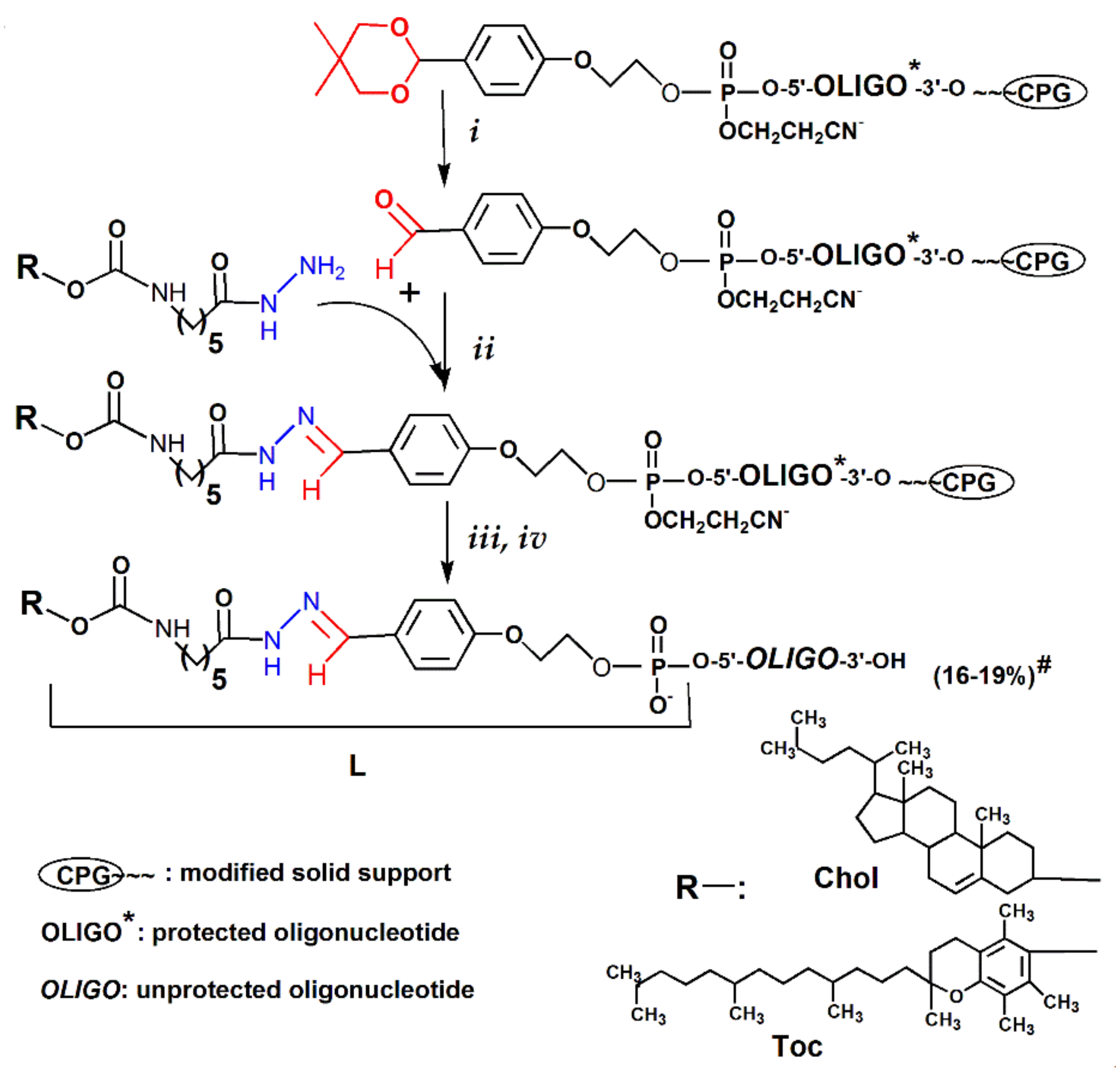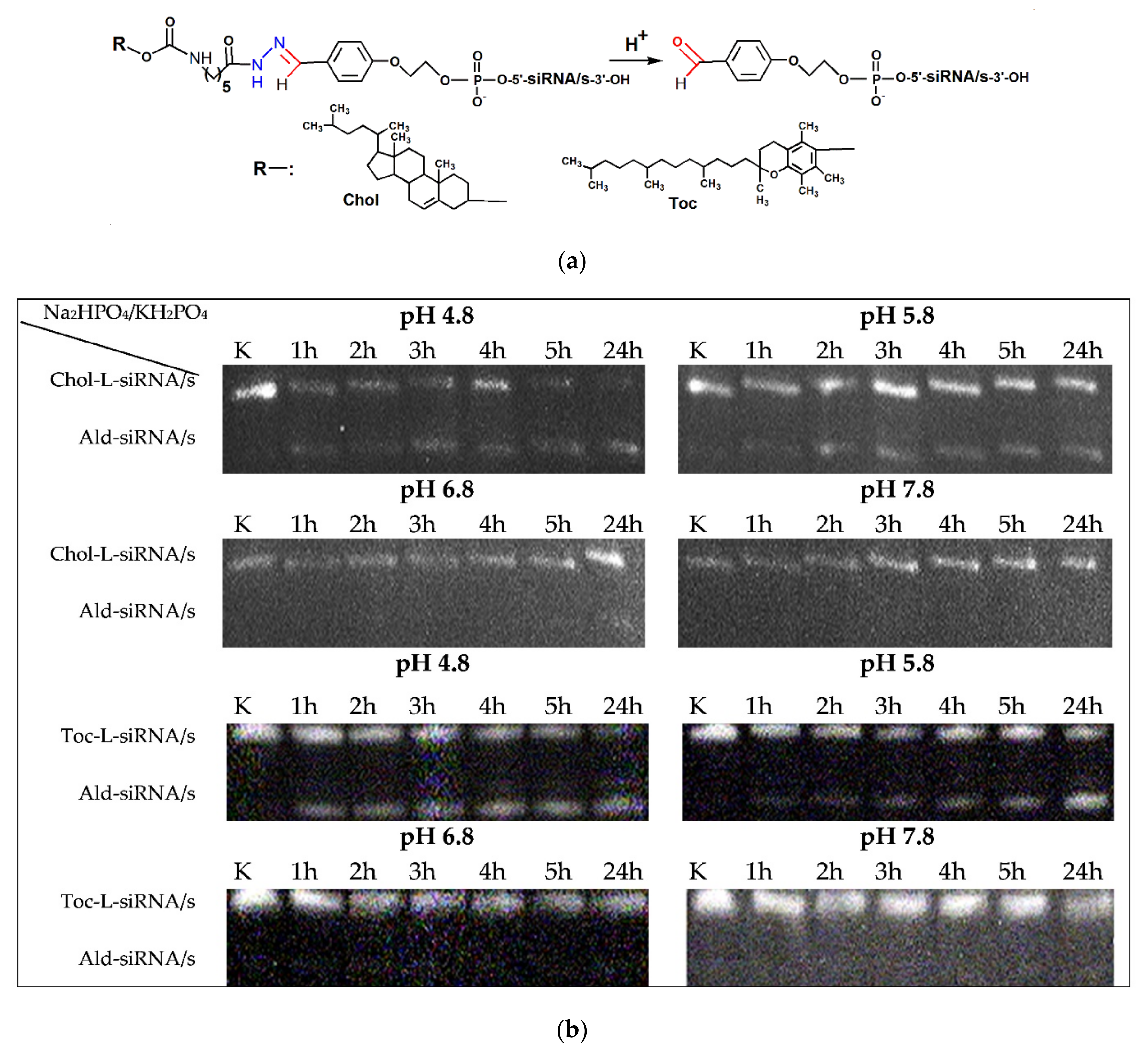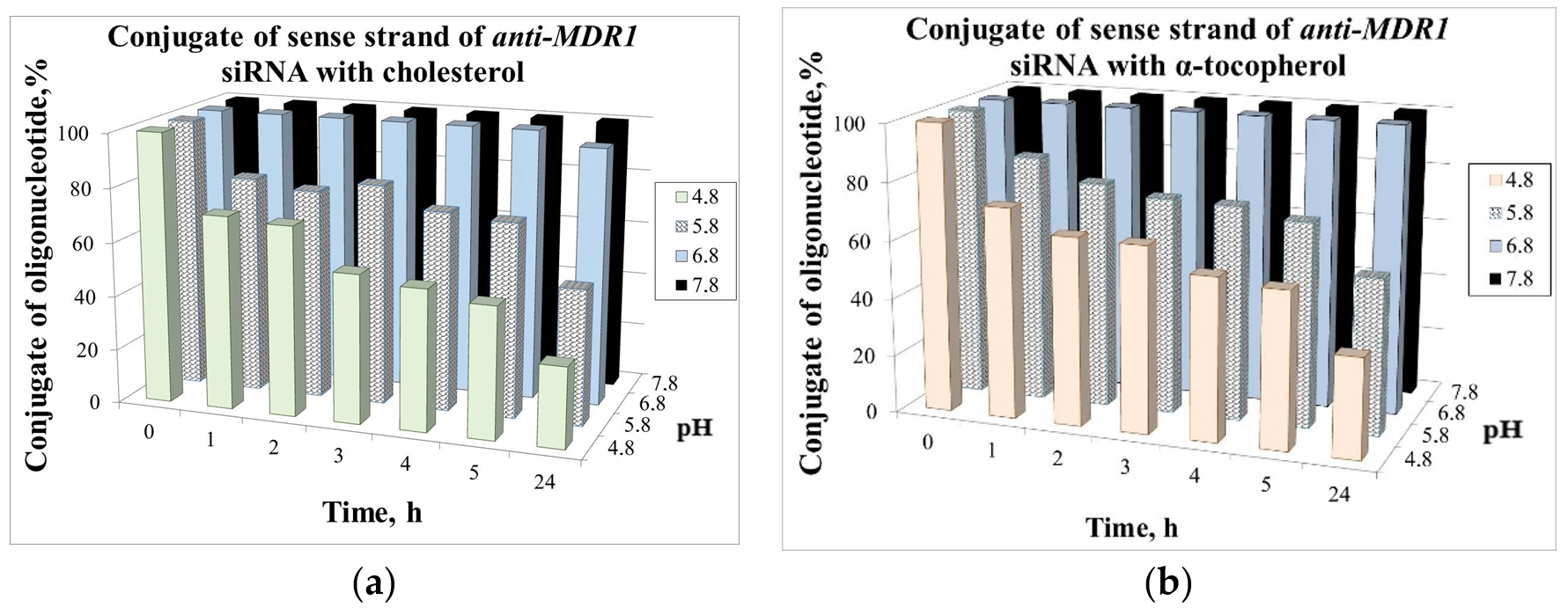A Versatile Solid-Phase Approach to the Synthesis of Oligonucleotide Conjugates with Biodegradable Hydrazone Linker
Abstract
1. Introduction
2. Results
2.1. Synthesis of Hydrazides of Lipophilic Compounds (VIII and IX)
2.2. Solid-Phase Synthesis of Lipophilic Conjugates of Oligonucleotides
| N | Conjugate | Sequence, 5′ → 3′ 1 | Type of Oligonucleotide |
|---|---|---|---|
| 1 | Chol-l-dT7 (7nt) | d(TTTTTTT) | Model oligodeoxyribonucleotide |
| 2 | Chol-l-siRNA/s (21nt) | Chol-l-GGCUUmGACmAAGUUmGUmAUmAUmGG | siRNA 2 |
| 3 | Toc-l-siRNA/s (21nt) | Toc-l-GGCUUmGACmAAGUUmGUmAUmAUmGG | |
| 4 | Chol-l-C57/1 (40nt) | Chol-l-CAAAUUUUAACUCUCCAAACGAGCCCCC UACAGGGCUCUU | Mitochondrial antireplicative RNAs 3 |
| 5 | Chol-l1-C57/1 (40nt) | Chol-l1-CAAAUUUUAACUCUCCAAACGAGCCCCC UACAGGGCUCUU 6 | |
| 6 | Chol-l-C57/2 (56nt) | Chol-l-GCGCAAUCGGUAGCGCCAAAUUUUAACUC UCCAAACGAGCCCCCUACAGGGCUCUU | |
| 7 | Chol-l1-C57/2 (56nt) | Chol-l1-GCGCAAUCGGUAGCGCCAAAUUUUAACUC UCCAAACGAGCCCCCUACAGGGCUCUU 6 | |
| 8 | Chol-l-C57/3 (56nt) | Chol-l-GCGCmAAUCmGGUmAGCGCCAAAUUUU AACUCUCCAAACGAGCCCCCUmACmAGGGCUCUU | |
| 9 | Chol-l-C57/4 (56nt) | Chol-l-GCGCmAAUCmGGUmAGCGCGUUU GGAGAGUUAAAAUUUGGAGCCCCCUmACmAGGGCUCUU | |
| 10 | Chol-l-HB/1 (56nt) | Chol-l-GCGCAmAUCmGGUmAGCGCAUCUUAACUCUC UUUUAACUGAGCCCCCUmACmAGGGCUCUU | |
| 11 | Chol-l-HB/2 (56nt) | Chol-l-GCGCmAAUCmGGUmAGCGCAGUUAAAA GAGAGUUAAGAUGAGCCCCCUmACmAGGGCUCUU | |
| 12 | Chol-l-KSS/1 (62nt) | Chol-l-GAGAAGUAAGCACUGUAAAGGUUUU AGAGCUAGAAAUAGCAAGUUAAAAUAAGGCUAGUCCG | sgRNAs 4 |
| 13 | Chol-l-KSS/2 (84nt) | Chol-l-GAGAAGUAAGCACUGUAAAGGUUUU AGAGCUAGAAAUAGCAAGUUAAAAUAAGGCUAGUCCG UUGAGCCCCCUACAGGGCUCUU | |
| 14 | Chol-l-crRNA/1 (40nt) | Chol-l-UAAUUUCUACUCUUGUAGAUGAU GAUGUGGUCUUUGGAGU | crRNAs 5 |
| 15 | Toc-l-crRNA/1 (40nt) | Toc-l-UAAUUUCUACUCUUGUAGAUGAU GAUGUGGUCUUUGGAGU | |
| 16 | Toc-l-crRNA/2 (40nt) | Toc-l-UAAUUUCUACUCUUGUAGAUGAU GAUGUGGUUUUUGGAGU | |
| 17 | Toc-l-crRNA/3 (40nt) | Toc-l-UAAUUUCUACUCUUGUAGAUGAU GAUGUGGCCUUUGGAGU |
2.3. Stability of the Lipophilic Conjugates at Different pH
3. Discussion
4. Materials and Methods
4.1. General Information
4.2. Synthesis of Hydrazides of Lipophilic Compounds (VIII) and (IX)
4.3. Solid-Phase Synthesis of Polymer-Bound Oligonucleotides and Their 5′-Aldehyde-Containing Derivatives
4.4. Optimization of the Solid-Phase Synthesis of Oligonucleotide Lipophilic Conjugates Containing Hydrazone Bond
4.5. Solid-Phase Synthesis of Oligoribonucleotide Lipophilic Conjugates Containing pH-Labile and Reduced Hydrazone Bond (2–17)
- Ald-siRNA/s: theoretical mass 7066.34 Da, measured mass 7065.34 Da (Supplementary Figure S10);
- Chol-l-siRNA/s (2): theoretical mass 7606.65 Da, measured mass 7603.70 Da (Supplementary Figure S11);
- Toc-l-siRNA/s (3): theoretical mass 7650.70 Da, measured mass 7651.13 Da (Supplementary Figure S12);
- Chol-l1-C57/1 (5): theoretical mass 13,390.19 Da, measured mass 13,391.36 Da (Supplementary Figure S13);
- Chol-l1-C57/2 (7): theoretical mass 18,587.28 Da, measured mass 18,587.84 Da (Supplementary Figure S14).
4.6. Stability of the Hydrazone Bond of the Lipophilic Oligonucleotide Conjugates (2, 3) at Different pH
5. Conclusions
Supplementary Materials
Author Contributions
Funding
Institutional Review Board Statement
Informed Consent Statement
Data Availability Statement
Acknowledgments
Conflicts of Interest
Sample Availability
References
- Smith, C.I.E.; Zain, R. Therapeutic oligonucleotides: State of the art. Annu. Rev. Pharmacol. Toxicol. 2019, 59, 605–630. [Google Scholar] [CrossRef] [PubMed]
- Kulabhusan, P.K.; Babar Hussain, B.; Yüce, M. Current perspectives on aptamers as diagnostic tools and therapeutic agents. Pharmaceutics 2020, 12, 646. [Google Scholar] [CrossRef] [PubMed]
- Chen, Q.; Zhang, Y.; Yin, Y. Recent advances in chemical modifications of guide RNA, mRNA and donor template for CRISPR-mediated genome editing. Adv. Drug Deliv. Rev. 2021, 168, 246–258. [Google Scholar] [CrossRef] [PubMed]
- Lönnberg, H. Solid-phase synthesis of oligonucleotide conjugates useful for delivery and targeting of potential nucleic acid therapeutics. Bioconjug. Chem. 2009, 20, 1065–1094. [Google Scholar] [CrossRef]
- Juliano, R.L. The delivery of therapeutic oligonucleotides. Nucleic Acids Res. 2016, 44, 6518–6548. [Google Scholar] [CrossRef]
- Roberts, T.C.; Langer, R.; Wood, M.J.A. Advances in oligonucleotide drug delivery. Nat. Rev. Drug Discov. 2020, 19, 673–694. [Google Scholar] [CrossRef]
- Winkler, J. Oligonucleotide conjugates for therapeutic applications. Ther. Deliv. 2013, 4, 791–809. [Google Scholar] [CrossRef]
- Ming, X.; Laing, B. Bioconjugates for targeted delivery of therapeutic oligonucleotides. Adv. Drug Deliv. Rev. 2015, 87, 81–89. [Google Scholar] [CrossRef]
- Taskova, M.; Mantsiou, A.; Astakhova, K. Synthetic nucleic acid analogues in gene therapy: An update for peptide-oligonucleotide conjugates. ChemBioChem 2017, 18, 1671–1682. [Google Scholar] [CrossRef]
- Grijalvo, S.; Alagia, A.; Jorge, A.F.; Eritja, R. Covalent strategies for targeting messenger and non-coding RNAs: An updated review on siRNA, miRNA and antimiR conjugates. Genes 2018, 9, 74. [Google Scholar] [CrossRef]
- Osborn, M.F.; Coles, A.H.; Biscans, A.; Haraszti, R.A.; Roux, L.; Davis, S.; Ly, S.; Echeverria, D.; Hassler, M.R.; Godinho, B.M.D.C.; et al. Hydrophobicity drives the systemic distribution of lipid-conjugated siRNAs via lipid transport pathways. Nucleic Acids Res. 2019, 47, 1070–1081. [Google Scholar] [CrossRef]
- Benizri, S.; Gissot, A.; Martin, A.; Vialet, B.; Grinstaff, M.W.; Barthélémy, P. Bioconjugated oligonucleotides: Recent developments and therapeutic applications. Bioconjug. Chem. 2019, 30, 366–383. [Google Scholar] [CrossRef]
- Nuzzo, S.; Roscigno, G.; Affinito, A.; Ingenito, F.; Quintavalle, C.; Condorelli, G. Potential and challenges of aptamers as specific carriers of therapeutic oligonucleotides for precision medicine in cancer. Cancers 2019, 11, 1521. [Google Scholar] [CrossRef]
- Meschaninova, M.I.; Novopashina, D.S.; Semikolenova, O.A.; Silnikov, V.N.; Venyaminova, A.G. Novel convenient approach to the solid-phase synthesis of oligonucleotide conjugates. Molecules 2019, 24, 4266. [Google Scholar] [CrossRef]
- Hawner, M.; Ducho, C. Cellular targeting of oligonucleotides by conjugation with small molecules. Molecules 2020, 25, 5963. [Google Scholar] [CrossRef]
- Maguregui, A.; Abe, H. Developments in siRNA modification and ligand conjugated delivery to enhance RNA interference ability. ChemBioChem 2020, 21, 1808–1815. [Google Scholar] [CrossRef]
- Cedillo, I.; Chreng, D.; Engle, E.; Chen, L.; McPherson, A.K.; Rodriguez, A.A. Synthesis of 5′-GalNAc-conjugated oligonucleotides: A comparison of solid and solution-phase conjugation strategies. Molecules 2017, 22, 1356. [Google Scholar] [CrossRef]
- Singh, Y.; Murat, P.; Defrancq, E. Recent developments in oligonucleotide conjugation. Chem. Soc. Rev. 2010, 39, 2054–2070. [Google Scholar] [CrossRef]
- Leriche, G.; Chisholm, L.; Wagner, A. Cleavable linkers in chemical biology. Bioorg. Med. Chem. 2011, 20, 571–582. [Google Scholar] [CrossRef]
- Kanamala, M.; Wilson, R.; Yang, M.; Palmer, B.D.; Wu, Z. Mechanisms and biomaterials in pH-responsive tumour targeted drug delivery: A review. Biomaterials 2016, 85, 152–167. [Google Scholar] [CrossRef]
- Guo, X.; Cheng, Y.; Zhao, X.; Luo, Y.; Chen, J.; Yuan, W.E. Advances in redox-responsive drug delivery systems of tumor microenvironment. J. Nanobiotechnol. 2018, 16, 74. [Google Scholar] [CrossRef] [PubMed]
- Sonawane, S.J.; Kalhapure, R.S.; Govender, T. Hydrazone linkages in pH responsive drug delivery systems. Eur. J. Pharm. Sci. 2017, 99, 45–65. [Google Scholar] [CrossRef]
- Yang, Y.; Mu, J.; Xing, B. Photoactivated drug delivery and bioimaging. WIREs Nanomed. Nanobiotechnol. 2017, 9, e1408. [Google Scholar] [CrossRef] [PubMed]
- Stasińska, A.R.; Putaj, P.; Chmielewski, M.K. Disulfide bridge as a linker in nucleic acids’ bioconjugation. Part II: A summary of practical applications. Bioorg. Chem. 2020, 95, 103518. [Google Scholar] [CrossRef] [PubMed]
- Aho, A.; Äärelä, A.; Korhonen, H.; Virta, P. Expanding the scope of the cleavable N-(methoxy) oxazolidine linker for the synthesis of oligonucleotide conjugates. Molecules 2021, 26, 490. [Google Scholar] [CrossRef] [PubMed]
- Smith, S.A.; Selby, L.I.; Johnston, A.P.R.; Such, G.K. The endosomal escape of nanoparticles: Toward more efficient cellular delivery. Bioconjug. Chem. 2019, 30, 263–272. [Google Scholar] [CrossRef] [PubMed]
- Gritsenko, O.M.; Gromova, E.S. Dialdehyde-containing nucleic acids and their components: Synthesis, properties and affinity modification of proteins. Russ. Chem. Rev. 1999, 68, 241–251. [Google Scholar] [CrossRef]
- Kachalova, A.V.; Zubin, E.M.; Oretskaya, T.S. Methods for the synthesis of oligonucleotides containing reactive electrophilic groups. Russ. Chem. Rev. 2002, 71, 1041–1059. [Google Scholar] [CrossRef]
- Zatsepin, T.S.; Stetsenko, D.A.; Gait, M.J.; Oretskaya, T.S. Use of carbonyl group addition—elimination reactions for synthesis of nucleic acid conjugates. Bioconjug. Chem. 2005, 16, 471–489. [Google Scholar] [CrossRef]
- Zatsepin, T.S.; Stetsenko, D.A.; Arzumanov, A.A.; Romanova, E.A.; Gait, M.J.; Oretskaya, T.S. Synthesis of peptide−oligonucleotide conjugates with single and multiple peptides attached to 2‘-aldehydes through thiazolidine, oxime, and hydrazine linkages. Bioconjug. Chem. 2002, 13, 822–830. [Google Scholar] [CrossRef]
- Zubin, E.M.; Stetsenko, D.A.; Oretskaya, T.S.; Gait, M.J. 1,2-diol and hydrazide phosphoramidites for solid-phase synthesis and chemoselective ligation of 2′-modified oligonucleotides. Nucleosides Nucleotides Nucleic Acids 2003, 22, 1375–1378. [Google Scholar] [CrossRef]
- Zubin, E.M.; Stetsenko, D.A.; Zatsepin, T.S.; Gait, M.J.; Oretskaya, T.S. Oligonucleotides containing 2′-O-[2-(2,3-dihydroxypropyl) amino-2-oxoethyl]uridine as suitable precursors of 2′-aldehyde oligonucleotides for chemoselective ligation. Bioorg. Med. Chem. 2005, 13, 4912–4920. [Google Scholar] [CrossRef]
- Khomyakova, E.A.; Zubin, E.M.; Pavlova, L.V.; Kazanova, E.V.; Smirnov, I.P.; Pozmogova, G.E.; Oretskaya, T.S. 2′-modified oligoribonucleotides containing 1,2-diol and aldehyde groups. Synthesis and properties. Russ. J. Bioorganic Chem. 2012, 38, 488–499. [Google Scholar] [CrossRef]
- Podyminogin, M.A.; Lukhtanov, E.A.; Reed, M.W. Attachment of benzaldehyde-modified oligodeoxynucleotide probes to semicarbazide-coated glass. Nucleic Acids Res. 2001, 29, 5090–5098. [Google Scholar] [CrossRef]
- Lartia, R. Synthesis of 5-aldehyde oligonucleotide. Curr. Protoc. Nucleic Acid Chem. 2016, 64, 4.70.1–4.70.12. [Google Scholar] [CrossRef]
- Ma, Y.; Lv, Z.; Li, T.; Tian, T.; Lu, L.; Liu, W.; Zhu, Z.; Yang, C. Design and synthesis of ortho-phthalaldehyde phosphoramidite for single-step, rapid, efficient and chemoselective coupling of DNA with proteins under physiological conditions. Chem. Commun. 2018, 54, 9434–9437. [Google Scholar] [CrossRef]
- Küpfer, P.A.; Leumann, C.J. RNA abasic sites: Preparation and trans-lesion synthesis by HIV-1 reverse transcriptase. ChemBioChem 2005, 6, 1970–1973. [Google Scholar] [CrossRef]
- Hirano, Y.; Kojima, N.; Komatsu, Y. Synthesis and application of interstrand cross-linked duplexes by covalently linking a pair of abasic sites. Curr. Protoc. Nucleic Acid Chem. 2018, 75, e63. [Google Scholar] [CrossRef]
- Ochkasova, A.S.; Meschaninova, M.I.; Venyaminova, A.G.; Ivanov, A.V.; Graifer, D.M.; Karpova, G.G. The human ribosome can interact with the abasic site in mRNA via a specific peptide of the uS3 protein located near the mRNA entry channel. Biochimie 2019, 158, 117–125. [Google Scholar] [CrossRef]
- He, J.; Liu, G.; Dou, S.; Gupta, S.; Rusckowski, M.; Hnatowich, D. An improved method for covalently conjugating morpholino oligomers to antitumor antibodies. Bioconjug. Chem. 2007, 18, 983–988. [Google Scholar] [CrossRef][Green Version]
- Flor, A.C.; Williams, J.H.; Blaine, K.M.; Duggan, R.C.; Sperling, A.I.; Schwartz, D.A.; Kron, S.J. DNA-directed assembly of antibody-fluorophore conjugates for quantitative multiparametric flow cytometry. ChemBioChem 2014, 15, 267–275. [Google Scholar] [CrossRef]
- He, Z.; Chen, Q.; Chen, F.; Zhang, J.; Li, H.; Lin, J.-M. DNA-mediated cell surface engineering for multiplexed glycan profiling using MALDI-TOF mass spectrometry. Chem. Sci. 2016, 7, 5448–5452. [Google Scholar] [CrossRef]
- Raddatz, S.; Mueller-Ibeler, J.; Kluge, J.; Wäss, L.; Burdinski, G.; Havens, J.R.; Onofrey, T.J.; Wang, D.; Schweitzer, M. Hydrazide oligonucleotides: New chemical modification for chip array attachment and conjugation. Nucleic Acids Res. 2002, 30, 4793–4802. [Google Scholar] [CrossRef]
- Kozlov, I.A.; Melnyk, P.C.; Stromsborg, K.E.; Chee, M.S.; Barker, D.L.; Zhao, C. Efficient strategies for the conjugation of oligonucleotides to antibodies enabling highly sensitive protein detection. Biopolymers 2004, 73, 621–630. [Google Scholar] [CrossRef]
- Asami, Y.; Yoshioka, K.; Nishina, K.; Nagata, T.; Yokota, T. Drug delivery system of therapeutic oligonucleotides. Drug Discov. Ther. 2016, 10, 256–262. [Google Scholar] [CrossRef]
- Chernikov, I.V.; Gladkikh, D.V.; Meshchaninova, M.I.; Venyaminova, A.G.; Zenkova, M.A.; Vlassov, V.V.; Chernolovskaya, E.L. Cholesterol-containing nuclease-resistant siRNA accumulates in tumors in a carrier-free mode and silences MDR1 gene. Mol. Ther. Nucleic Acids 2017, 6, 209–220. [Google Scholar] [CrossRef]
- Bolin, D.R.; Sytwu, I.I.; Humiec, F.; Meienhofer, J. Preparation of oligomer-free Nα-Fmoc and Nα-urethane amino acids. Int. J. Pept. Protein Res. 1989, 33, 353–359. [Google Scholar] [CrossRef]
- Dovydenko, I.; Tarassov, I.; Venyaminova, A.; Entelis, N. Method of carrier-free delivery of therapeutic RNA importable into human mitochondria: Lipophilic conjugates with cleavable bonds. Biomaterials 2016, 76, 408–417. [Google Scholar] [CrossRef]
- Volkov, A.A.; Kruglova, N.S.; Meschaninova, M.I.; Venyaminova, A.G.; Zenkova, M.A.; Vlassov, V.V.; Chernolovskaya, E.L. Selective protection of nuclease-sensitive sites in siRNA prolongs silencing effect. Oligonucleotides 2009, 19, 191–202. [Google Scholar] [CrossRef]
- Tonin, Y.; Heckel, A.M.; Dovydenko, I.; Meschaninova, M.; Comte, C.; Venyaminova, A.; Pyshnyi, D.; Tarassov, I.; Entelis, N. Characterization of chemically modified oligonucleotides targeting a pathogenic mutation in human mitochondrial DNA. Biochimie 2014, 100, 192–199. [Google Scholar] [CrossRef]
- Burgstaller, J.P.; Johnston, I.G.; Jones, N.S.; Albrechtová, J.; Kolbe, T.; Vogl, C.; Futschik, A.; Mayrhofer, C.; Klein, D.; Sabitzer, S.; et al. MtDNA segregation in heteroplasmic tissues is common in vivo and modulated by haplotype differences and developmental stage. Cell Rep. 2014, 7, 2031–2041. [Google Scholar] [CrossRef] [PubMed]
- Loutre, R.; Heckel, A.M.; Smirnova, A.; Entelis, N.; Tarassov, I. Can Mitochondrial DNA be CRISPRized: Pro and Contra. IUBMB Life 2018, 70, 1233–1239. [Google Scholar] [CrossRef] [PubMed]
- Zetsche, B.; Gootenberg, J.; Abudayyeh, O.; Slaymaker, I.; Makarova, K.; Essletzbichler, P.; Volz, S.; Joung, J.; van der Oost, J.; Regev, A.; et al. Cpf1 is a single RNA-guided endonuclease of a class 2 CRISPR-Cas system. Cell 2015, 163, 759–771. [Google Scholar] [CrossRef] [PubMed]
- Zhou, Y.; Guan, J.; Gao, W.; Lv, S.; Ge, M. Quantification and confirmation of fifteen carbamate pesticide residues by multiple reaction monitoring and enhanced product ion scan modes via LC-MS/MS QTRAP system. Molecules 2018, 23, 2496. [Google Scholar] [CrossRef]
- Kölmel, D.K.; Kool, E.T. Oximes and hydrazones in bioconjugation: Mechanism and catalysis. Chem. Rev. 2017, 117, 10358–10376. [Google Scholar] [CrossRef]
- Kratz, F.; Beyer, U.; Schutte, M.T. Drug-polymer conjugates containing acid-cleavable bonds. Crit. Rev. Ther. Drug Carrier Syst. 1999, 16, 245–288. [Google Scholar] [CrossRef]
- Zatsepin, T.S.; Oretskaya, T.S.; Stetsenko, D.A.; Gait, M.J. Synthesis of DNA conjugates by solid-phase fragment condensation via aldehyde-nucleophile coupling. Tetrahedron Lett. 2005, 46, 3191–3195. [Google Scholar] [CrossRef]
- Zatsepin, T.S.; Stetsenko, D.A.; Gait, M.J.; Oretskaya, S. 2′-Hydrazine oligonucleotides: Synthesis and efficient conjugation with aldehydes. Nucleic Acids Symp. Ser. 2005, 49, 133–134. [Google Scholar] [CrossRef]
- Glen Report 20.24: Deprotection—Volume 1–Deprotect to Completion. Available online: https://www.glenresearch.com/reports/gr20-24 (accessed on 7 April 2021).
- Glen Report 21.15: Deprotection–Volume 2–RNA Deprotection. Available online: https://www.glenresearch.com/reports/gr21-15 (accessed on 7 April 2021).
- Westman, E.; Strömberg, R. Removal of t-butyldimethylsilyl protection in RNA-synthesis. Triethylamine trihydrofluoride (TEA, 3HF) is a more reliable alternative to tetrabutylammonium fluoride (TBAF). Nucleic Acids Res. 1994, 22, 2430–2431. [Google Scholar] [CrossRef]
- Proudnikov, D.; Mirzabekov, A. Chemical methods of DNA and RNA fluorescent labeling. Nucleic Acids Res. 1996, 24, 4535–4542. [Google Scholar] [CrossRef]





Publisher’s Note: MDPI stays neutral with regard to jurisdictional claims in published maps and institutional affiliations. |
© 2021 by the authors. Licensee MDPI, Basel, Switzerland. This article is an open access article distributed under the terms and conditions of the Creative Commons Attribution (CC BY) license (https://creativecommons.org/licenses/by/4.0/).
Share and Cite
Meschaninova, M.I.; Entelis, N.S.; Chernolovskaya, E.L.; Venyaminova, A.G. A Versatile Solid-Phase Approach to the Synthesis of Oligonucleotide Conjugates with Biodegradable Hydrazone Linker. Molecules 2021, 26, 2119. https://doi.org/10.3390/molecules26082119
Meschaninova MI, Entelis NS, Chernolovskaya EL, Venyaminova AG. A Versatile Solid-Phase Approach to the Synthesis of Oligonucleotide Conjugates with Biodegradable Hydrazone Linker. Molecules. 2021; 26(8):2119. https://doi.org/10.3390/molecules26082119
Chicago/Turabian StyleMeschaninova, Mariya I., Nina S. Entelis, Elena L. Chernolovskaya, and Alya G. Venyaminova. 2021. "A Versatile Solid-Phase Approach to the Synthesis of Oligonucleotide Conjugates with Biodegradable Hydrazone Linker" Molecules 26, no. 8: 2119. https://doi.org/10.3390/molecules26082119
APA StyleMeschaninova, M. I., Entelis, N. S., Chernolovskaya, E. L., & Venyaminova, A. G. (2021). A Versatile Solid-Phase Approach to the Synthesis of Oligonucleotide Conjugates with Biodegradable Hydrazone Linker. Molecules, 26(8), 2119. https://doi.org/10.3390/molecules26082119







